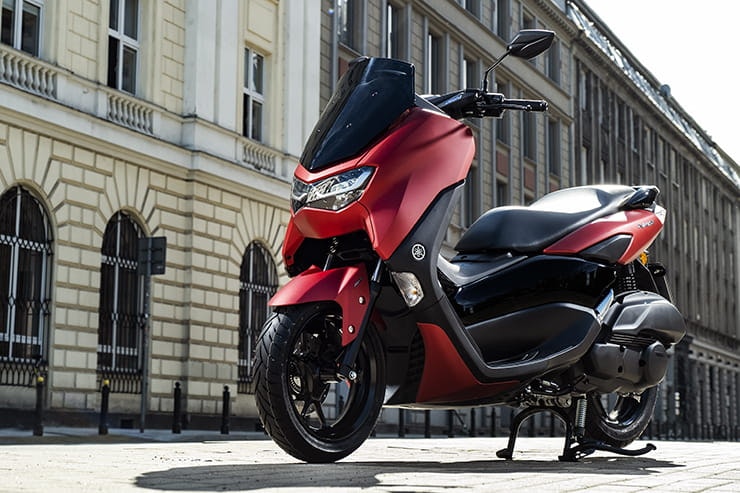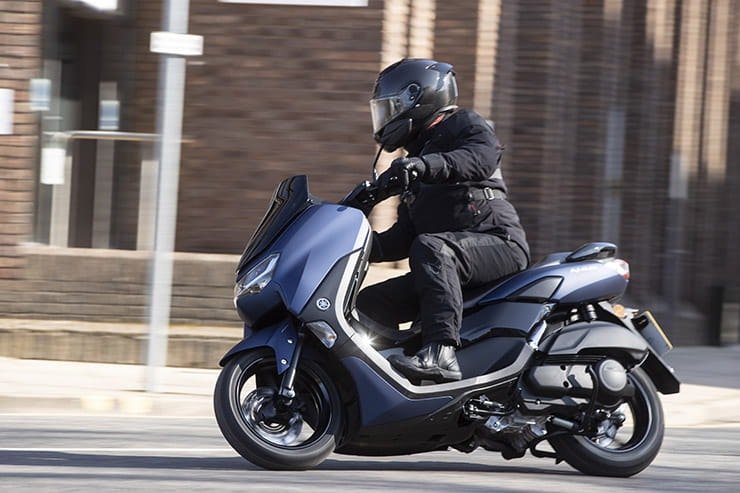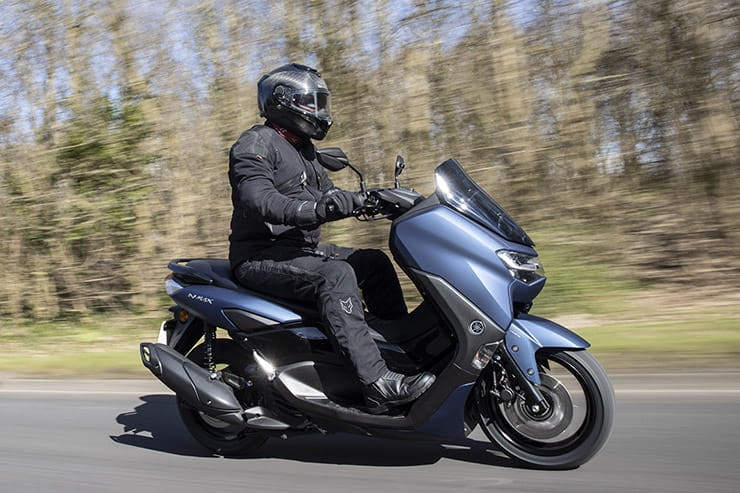Yamaha NMAX 125 (2021) - Review
By Stephen Lamb
Production Manager
12.03.2021
Helmet
Shark Spartan GT - £429.99
www.nevis.uk.com
Jacket
Wolf Fortitude Laminated - £349.99
www.wolf-moto.com
Trousers
Wolf Fortitude Laminated - £249.99
www.wolf-moto.com
Gloves
Wolf Fortitude - £79.99
www.wolf-moto.com
Boots
RST Pathfinder - £149.99
www.rst-moto.com
Each month, the Motorcycle Industry Association (MCIA) publish UK sales figures by type of bike (Scooters, Nakeds, Sports etc) as well as an overall sales chart. Top of the overall sales chart is usually the Honda PCX125 Scooter.
The combination of high quality, ease of use, value for money and Honda reliability have proven to be the winning formula for the PCX, but for how long?
Yamaha's NMAX 125 is usually one or two places behind the PCX (with BMW's mighty R1250GS between them) but this year, Yamaha have their sights firmly set on that coveted number one spot with the new for 2021 Yamaha NMAX 125.
We spent a day with one in its typical environment – a city centre – to see if the little Yamaha can take on the champ and beat it at its own game.
Keyless ignition means no more digging through pockets for your key
TCS gives ultimate confidence in sketchy conditions
Combined generator/starter is a stroke of genius
Front storage cubbies aren't lockable
A large full-face helmet won’t fit under the seat
Standard screen provides limited wind protection at speed
What's new for 2021
At first glance you might assume that the 2021 bike is the result of just a styling facelift, but look a bit further and there is much more to the new bike.
A new, more rigid frame forms the backbone of the new bike with a focus on improved rider comfort around the feet, suspension enhancements and optimisation for the mounting of top boxes - Yamaha clearly have heavy-handed delivery riders in mind.
As with any new for 2021 bike, the engine is now fully Euro 5 compliant and this has been achieved with no detriment to peak power and torque. The NMAX engine was already unique in class due its Variable Valve Actuation (VVA), providing improved torque at higher revs, but for 2021, the bar has been raised again with the addition of traction control and a Start / Stop system to aid fuel consumption and reduce emissions.
Finally, the dash gets a refresh, maintaining its LCD display, but gaining Bluetooth connectivity to provide phone notifications to the dash, and allow data to be downloaded to the connected smartphone via Yamaha's free MyRide app.
2021 YAMAHA NMAX Price
Price is always key in this sector of the market with not only Honda setting expectations with their PCX, but also the influx of low-cost bikes from China.
At £3399 on the road, Yamaha are pitching the bike squarely at their main sales rival, being just £230 more than the PCX.
If you are looking for PCP, various deals are available depending on the deposit size, but a typical example is detailed below (based on 4000 miles per annum).
For 2021, the NMAX is available in three colours - Anodised Red (Matte with metallic flake), Phantom Blue (Matte), and Power Grey (a gloss grey). All colours look great on the bike and give the scooter a real premium look, despite all being available at the same price.
Power and licence eligibility
Every horsepower counts in the scooter sector and the NMAX comes in just under the limit for a CBT compliant bike at 12bhp/9.0kW (the limit for taking your CBT is 15bhp/11kW) with peak power being delivered at 8000rpm. Combined with a peak torque figure of 11.2Nm, this makes for swift progress away from the lights and a terminal velocity of around 70mph (wind, incline and length of road allowing).
Out on the road, the NMAX never really feels lacking and allows you to make smart progress through even the heaviest traffic.
Engine and transmission
For me, the jewel in the crown of the NMAX is the engine. Even from its introduction in 2015, the NMAX engine was unique in class thanks to its Variable Valve Actuation system – first introduced on the YFZ-R125 sportsbike. It's used to extend the inlet valve opening time via a second inlet rocker arm which follows an additional cam lobe. When the VVA actuates, a pin engages between the two inlet arms, effectively making them a single arm, which now follows the higher profile on the cam. The result is that the engine can run optimally both at low and at higher revs. On the road, the transition is hardly noticeable, apart from a slight change in exhaust note (and an indicator on the dash). The result though is a smooth linear power delivery that means that whatever your speed, the bike is responsive and willing.
As if VVA weren't enough to make the NMAX stand out from the crowd, for 2021 it also comes with traction control as standard. Yes, you read that right – traction control on a 12hp scooter. Overkill? Well, for most riders and conditions, yes of course. But, for those one or two times when you're riding on cobbled streets, or a roundabout and find that the local haulier has jettisoned a couple of litres of Esso's finest on the road, or if you live in Manchester, Edinburgh, Croydon or any other of the increasing number of cities that have a matrix of tramlines covering its streets, then the presence of traction control could well be the difference between a slight wobble and sharp intake of breath, and a ruined day. Like ABS, its very presence gives reassurance to beginners and more experienced rider alike. What's not to like about that?
So, how much more tech can Yamaha cram into such a small engine? Quite a bit when it comes to the NMAX. Stop/start technology isn't new in this sector – Honda's PCX and SH scooters have had it for a few years now - so the addition of this to the 2021 NMAX comes as no surprise. What makes Yamaha's system unique though is the clever use of the generator to replace the starter motor. A traditional scooter engine has two discrete systems – a starter motor connects to the drivetrain via a gear to the clutch and disengages when the motor is turning, while a generator stator, mounted on the end of the crank, spins in windings, and generates all the electrical power needed to run the bike and ancillaries. Yamaha have combined the two functions by sending charge from the battery directly to the generator, effectively turning it into a motor and starting the engine, thereby eliminating the need for an additional starter motor. Not only does this save the weight of the starter motor but the system is significantly quieter as there are no intermediate gears to be driven. The result to the rider is that the traditional whine of a starter motor is gone – just thumb the button once and the engine starts. On the move, once the engine temperature and battery condition criteria have been met, the stop/start system cuts the engine when you come to a rest. Once the lights go green, simply twist the throttle and the engine instantly springs to life. It's such an elegant and simple solution, I expect we'll see it rolled out more widely on the Yamaha range in the future.
Yamaha's Smart Motor Generator
An easy-to-understand video describing how Yamaha’s Smart Motor Generator works.
2021 YAMAHA NMAX Economy
It takes some recalibration of expectations when you consider fuel economy for scooters as figures well over 100mpg are not uncommon. The combination of the stop/start system and Yamaha's 'Blue Core' engine philosophy, which includes low-friction engine components and closed loop fuel injection, mean that Yamaha quote an official figure of 2.2L/100km or 128.4mpg.
Clearly this is measured in ideal conditions, as after a few hours of riding on test, I was seeing an average closer to 98mpg. This is caveated though by saying that I was not riding conservatively (what do you expect when you send out the motoring press on identical bikes!) and that once the heady excitement of a new bike subsides, I would expect that figure to climb substantially.
A quick look on Fuelly.com shows that figures between 93.5 and 113 were being reported for the previous model, so with a light touch and favourable conditions, the official figures are certainly something to aim for. Combine this frugality with a slightly larger tank for 2021 (7.1 litres, up from 6.8 litres) and you get a full range of around 200 miles per tank – enough for a 40-mile daily commute for well under a tenner a week.
Handling, wheels and weight
Right from the off, the handling on the NMAX is reassuring and confidence inspiring. The 2021 model has slightly tweaked suspension over the outgoing model with slightly firmer forks upfront and revised valving to the rear shocks and, while I don’t think the difference will be noticeable to anyone but the most ardent fan, it all goes to make riding the bike an absolute breeze.
The rear shocks now also come equipped with two preload settings, adding a little extra firmness for pillions or heavy loads, adjusted with a simple twist of the collar mounted at the shock top.
The new model continues to use 13" wheels front and rear, which not only adds to the stable ride - avoiding the twitchiness that can so easily come with smaller wheels – but also means that there is a good selection of top brand tyres available for the NMAX. The standard UK fitment Dunlop ScootSmart tyres are perfectly suited to the bike and provide confidence right from the off.
With an all up wet weight of 131Kg, the NMAX feels reassuringly stable without being heavy or slow to turn. There are lighter scooters available (Yamaha's own 125cc D'elight for example), but the combination of low seat height and narrow footboard mean that the NMAX is easily to manoeuvre and never feels unwieldy.
2021 YAMAHA NMAX Brakes
The NMAX is equipped with single 230mm discs at both front and rear. Both are also equipped with ABS where many scooters make use of a linked system to balance braking for beginners. On test, it took some heavy-handed provocation to get the rear ABS to engage, but when it did, the operation was smooth and predictable, while still allowing a pleasing chirp of rubber on tarmac just prior to system engagement.
The combination of engine braking, light weight and flickable handling means that you never really have to do any heavy braking, but when you do, its reassuring to know than you can rely on them to get the job done.
At slow speeds, there is enough feel from the rear brake to allow you to drag the brake and keep the bike stable at walking pace or during U-turns, while the front is snatch-free meaning that, even for beginners, it's unlikely than you will unsettle the bike at low speeds.
Urban pack comprises 39l top box with mounting rack and lock, backrest pad, and high screen with integral hand deflectors, all for £437.30
Comfort and protection
With a seat height of just 765mm, the NMAX is approachable for all but the slightest of frames. At 5'6" I was easily able to flat foot the bike but still found the riding position roomy when on the move. The footboards are long and allow for a variety of riding positions from sit-up-and-beg with feet below your hips, to a more relaxed position with feet out front.
The front profile and small windscreen do a reasonable job at deflecting much of the wind around the rider, but if you're planning some longer journeys, the optional tall screen with integral hand deflectors might be a good investment - as shown above as part of the Urban Pack.
Rider aids and accessories
The NMAX's high-tech specification continues to the dash with a revised LCD display and keyless ignition.
As someone who seems to spend an inordinate amount of time faffing with helmets straps, pocket zips and gloves, only to then remember that the ignition key in in my pocket, I truly welcome keyless ignition as a major convenience. Just as the bigger (and much more expensive) XMAX range, there's a nice big multifunction knob on the leg guard which operates the ignition, steering lock and permits use of the two buttons used to open the seat and the fuel filler.
Above that, the revised LCD screen shows you most of what you could want to know, from engine temperature to fuel range, but this year is supplemented by incoming phone call and message alerts, and battery level indication from your Bluetooth connected phone. It is a notification system only – you can't control your phone from the bike, but once stopped, you can download data from the bike to your phone using the Myride app. One notable omission though, and a pet peeve of mine, is the lack of an air temperature indicator. On early morning commutes, its always nice to know the approximate air temperature - especially when its hovering around zero - and to be able to adjust your riding accordingly.
As you would expect, a full range of accessories is available from the get-go, including a taller screen mentioned above, 39 and 30 litre top boxes, smart alloy footplate covers, an open accessory mount with USB charging point for mounting a phone or satnav, an 18L console bag that sits on the transmission hump between your feet and a modified throttle tube to allow multi-application Yamaha heated grips to be fitted.
2021 YAMAHA NMAX storage capacity
If you don’t splash out on the accessory storage options listed above, the underseat storage provides a full 23 litres of stowage. While this sounds sufficient for most needs, and Yamaha claim that it's enough to stow a full-face helmet, I was unable to get my Shark Spartan GT in with the seat closed and many of my fellow test riders struggled with their range of helmets. Clearly, not a deal breaker, but it's worth considering your choice of headgear if you are planning to leave the bike at the station and don’t want to carry a helmet with you on the train.
The leg guard also contains two storage cubbies. These are large enough to fit a decent sized smartphone or bottle of water and the left one is open and equipped with a 12V 1A barrel type power outlet allowing for either phone or satnav charging on the go, once a USB adaptor is installed. The right cubby has a closable cover, though this is sadly not lockable, so not suitable for valuables.
Rivals
When it comes to rivals to the NMAX, we could consider a range of scooters from the £1999 Lexmoto Aura right up to the £4249 Kawasaki J125, but we all know that the NMAX will go head-to-head against Honda's PCX (which has also been revised for 2021), so here's how they stack up on paper:
2021 YAMAHA NMAX verdict
Minor niggles aside (and they are minor), the 2021 NMAX is a fantastic package. The combination of strong and willing engine, agile yet stable handling and stylish design make the NMAX serious contender for the top spot. But is it enough?
On paper, it's all too close to call with both bikes having near identical stats. We're yet to ride the 2021 Honda PCX, so can't call it definitively one way or the other, but my money would be on the Yamaha, despite that small price premium.
For me (and this is a purely personal choice, your view may well differ), the satin colour schemes (especially the gorgeous Phantom Blue), the innovative start system and the funky styling give the Yamaha enough of an emotional edge to make up for the price difference.
One this is for sure, it's going to be a close race, and we can't wait to see how it plays out.
2021 YAMAHA NMAX spec
Looking for scooter or moped insurance? Get a quote for this machine with Bennetts moped and scooter insurance
What is MCIA Secured?
MCIA Secured gives bike buyers the chance to see just how much work a manufacturer has put into making their new investment as resistant to theft as possible.
As we all know, the more security you use, the less chance there is of your bike being stolen. In fact, based on research by Bennetts, using a disc lock makes your machine three times less likely to be stolen, while heavy duty kit can make it less likely to be stolen than a car. For reviews of the best security products, click here.
MCIA Secured gives motorcycles a rating out of five stars, based on the following being fitted to a new bike as standard:
A steering lock that meets the UNECE 62 standard
An ignition immobiliser system
A vehicle marking system
An alarm system
A vehicle tracking system with subscription
The higher the star rating, the better the security, so always ask your dealer what rating your bike has, and compare it to other machines on your shortlist.
Moped and Scooter Insurance
Getting a moped insurance quote is easy with Bennetts – we’ll do the legwork to find you the best premium for your requirements from our panel.
Simply complete our online form for an instant scooter insurance quote, or call our dedicated UK-based call centre on 0330 018 7990, who are on hand 24 hours a day, seven days a week to find our best deal for you.


